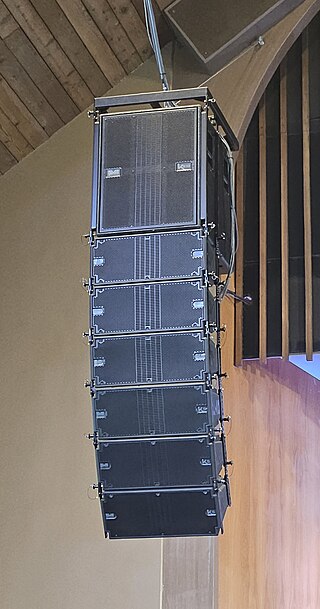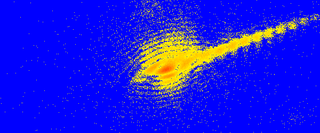Related Research Articles

Sonar is a technique that uses sound propagation to navigate, measure distances (ranging), communicate with or detect objects on or under the surface of the water, such as other vessels.

A microphone, colloquially called a mic, or mike, is a transducer that converts sound into an electrical signal. Microphones are used in many applications such as telephones, hearing aids, public address systems for concert halls and public events, motion picture production, live and recorded audio engineering, sound recording, two-way radios, megaphones, and radio and television broadcasting. They are also used in computers and other electronic devices, such as mobile phones, for recording sounds, speech recognition, VoIP, and other purposes, such as ultrasonic sensors or knock sensors.

Holography is a technique that enables a wavefront to be recorded and later reconstructed. It is best known as a method of generating three-dimensional images, and has a wide range of other uses, including data storage, microscopy, and interferometry. In principle, it is possible to make a hologram for any type of wave.

Interferometry is a technique which uses the interference of superimposed waves to extract information. Interferometry typically uses electromagnetic waves and is an important investigative technique in the fields of astronomy, fiber optics, engineering metrology, optical metrology, oceanography, seismology, spectroscopy, quantum mechanics, nuclear and particle physics, plasma physics, biomolecular interactions, surface profiling, microfluidics, mechanical stress/strain measurement, velocimetry, optometry, and making holograms.

Directional Sound refers to the notion of using various devices to create fields of sound which spread less than most (small) traditional loudspeakers. Several techniques are available to accomplish this, and each has its benefits and drawbacks. Ultimately, choosing a directional sound device depends greatly on the environment in which it is deployed as well as the content that will be reproduced. Keeping these factors in mind will yield the best results through any evaluation of directional sound technologies.
Inverse synthetic-aperture radar (ISAR) is a radar technique using radar imaging to generate a two-dimensional high resolution image of a target. It is analogous to conventional SAR, except that ISAR technology uses the movement of the target rather than the emitter to create the synthetic aperture. ISAR radars have a significant role aboard maritime patrol aircraft to provide them with radar image of sufficient quality to allow it to be used for target recognition purposes. In situations where other radars display only a single unidentifiable bright moving pixel, the ISAR image is often adequate to discriminate between various missiles, military aircraft, and civilian aircraft.
Holonomic brain theory is a branch of neuroscience investigating the idea that human consciousness is formed by quantum effects in or between brain cells. Holonomic refers to representations in a Hilbert phase space defined by both spectral and space-time coordinates. Holonomic brain theory is opposed by traditional neuroscience, which investigates the brain's behavior by looking at patterns of neurons and the surrounding chemistry.

Digital room correction is a process in the field of acoustics where digital filters designed to ameliorate unfavorable effects of a room's acoustics are applied to the input of a sound reproduction system. Modern room correction systems produce substantial improvements in the time domain and frequency domain response of the sound reproduction system.

The optical transfer function (OTF) of an optical system such as a camera, microscope, human eye, or projector specifies how different spatial frequencies are captured or transmitted. It is used by optical engineers to describe how the optics project light from the object or scene onto a photographic film, detector array, retina, screen, or simply the next item in the optical transmission chain. A variant, the modulation transfer function (MTF), neglects phase effects, but is equivalent to the OTF in many situations.
Electron holography is holography with electron matter waves. It was invented by Dennis Gabor in 1948 when he tried to improve image resolution in electron microscope. The first attempts to perform holography with electron waves were made by Haine and Mulvey in 1952; they recorded holograms of zinc oxide crystals with 60 keV electrons, demonstrating reconstructions with approximately 1 nm resolution. In 1955, G. Möllenstedt and H. Düker invented an electron biprism, thus enabling the recording of electron holograms in off-axis scheme. There are many different possible configurations for electron holography, with more than 20 documented in 1992 by Cowley. Usually, high spatial and temporal coherence of the electron beam are required to perform holographic measurements.
The angular spectrum method is a technique for modeling the propagation of a wave field. This technique involves expanding a complex wave field into a summation of infinite number of plane waves of the same frequency and different directions. Its mathematical origins lie in the field of Fourier optics but it has been applied extensively in the field of ultrasound. The technique can predict an acoustic pressure field distribution over a plane, based upon knowledge of the pressure field distribution at a parallel plane. Predictions in both the forward and backward propagation directions are possible.
Computer-generated holography (CGH) is a technique that uses computer algorithms to generate holograms. It involves generating holographic interference patterns. A computer-generated hologram can be displayed on a dynamic holographic display, or it can be printed onto a mask or film using lithography. When a hologram is printed onto a mask or film, it is then illuminated by a coherent light source to display the holographic images.

Coherent diffractive imaging (CDI) is a "lensless" technique for 2D or 3D reconstruction of the image of nanoscale structures such as nanotubes, nanocrystals, porous nanocrystalline layers, defects, potentially proteins, and more. In CDI, a highly coherent beam of X-rays, electrons or other wavelike particle or photon is incident on an object.
Acoustic microscopy is microscopy that employs very high or ultra high frequency ultrasound. Acoustic microscopes operate non-destructively and penetrate most solid materials to make visible images of internal features, including defects such as cracks, delaminations and voids.

Thermoacoustic imaging was originally proposed by Theodore Bowen in 1981 as a strategy for studying the absorption properties of human tissue using virtually any kind of electromagnetic radiation. But Alexander Graham Bell first reported the physical principle upon which thermoacoustic imaging is based a century earlier. He observed that audible sound could be created by illuminating an intermittent beam of sunlight onto a rubber sheet. Shortly after Bowen's work was published, other researchers proposed methodology for thermoacoustic imaging using microwaves. In 1994 researchers used an infrared laser to produce the first thermoacoustic images of near-infrared optical absorption in a tissue-mimicking phantom, albeit in two dimensions (2D). In 1995 other researchers formulated a general reconstruction algorithm by which 2D thermoacoustic images could be computed from their "projections," i.e. thermoacoustic computed tomography (TCT). By 1998 researchers at Indiana University Medical Center extended TCT to 3D and employed pulsed microwaves to produce the first fully three-dimensional (3D) thermoacoustic images of biologic tissue [an excised lamb kidney ]. The following year they created the first fully 3D thermoacoustic images of cancer in the human breast, again using pulsed microwaves. Since that time, thermoacoustic imaging has gained widespread popularity in research institutions worldwide. As of 2008, three companies were developing commercial thermoacoustic imaging systems – Seno Medical, Endra, Inc. and OptoSonics, Inc.

Scanning near-field ultrasound holography (SNFUH) is a method for performing nondestructive nano-scale high-resolution imaging of buried and embedded structures. SNFUH is critical for analysis of materials, structures and phenomena as they continue to shrink at the micro/nano scale. SNFUH is a type of scanning probe microscopy (SPM) technique that provides depth information as well as spatial resolution at the 10 to 100 nm scale.
An acoustic camera is an imaging device used to locate sound sources and to characterize them. It consists of a group of microphones, also called a microphone array, from which signals are simultaneously collected and processed to form a representation of the location of the sound sources.
3D sound reconstruction is the application of reconstruction techniques to 3D sound localization technology. These methods of reconstructing three-dimensional sound are used to recreate sounds to match natural environments and provide spatial cues of the sound source. They also see applications in creating 3D visualizations on a sound field to include physical aspects of sound waves including direction, pressure, and intensity. This technology is used in entertainment to reproduce a live performance through computer speakers. The technology is also used in military applications to determine location of sound sources. Reconstructing sound fields is also applicable to medical imaging to measure points in ultrasound.
Super-resolution photoacoustic imaging is a set of techniques used to enhance spatial resolution in photoacoustic imaging. Specifically, these techniques primarily break the optical diffraction limit of the photoacoustic imaging system. It can be achieved in a variety of mechanisms, such as blind structured illumination, multi-speckle illumination, or photo-imprint photoacoustic microscopy in Figure 1.
The time-domain counterpart of spatial holography is called time-domain holography. In other words, the principles of spatial holography is surveyed in time domain. Time-domain holography was inspired by the theory known as space-time duality which was introduced by Brian H. Kolner in 1994.
References
- 1 2 3 Williams, Earl G. (2004). "Acoustic holography". McGraw-Hill Concise Encyclopedia of Science and Technology (5 ed.). New York: McGraw-Hill.
- ↑ J. D. Maynard; E. G. Williams; Y. Lee (October 1985). "Nearfield acoustic holography: I. Theory of generalized holography and the development of NAH". The Journal of the Acoustical Society of America. 78 (4): 1395–1413. Bibcode:1985ASAJ...78.1395M. doi:10.1121/1.392911.
- ↑ Scholte, Rick (2008). Fourier based high-resolution near-field sound imaging (PDF). Technische Universiteit Eindhoven. doi:10.6100/IR639528.
- ↑ Hald, Jørgen (25 August 2003). Patch near-field acoustical holography using a new statistically-optimal method (PDF). 32nd International Congress on Noise Control Engineering. Seogwipo, Korea.